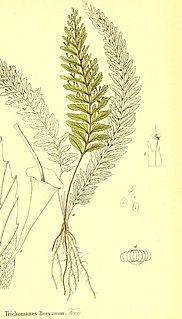
Network address translation (NAT) is a method of mapping an IP address space into another by modifying network address information in the IP header of packets while they are in transit across a traffic routing device. The technique was originally used to avoid the need to assign a new address to every host when a network was moved, or when the upstream Internet service provider was replaced, but could not route the networks address space. It has become a popular and essential tool in conserving global address space in the face of IPv4 address exhaustion. One Internet-routable IP address of a NAT gateway can be used for an entire private network.

Sphaerium corneum, also known as the European fingernailclam, is a very small freshwater clam, an aquatic bivalve mollusk in the family Sphaeriidae, the fingernail clams.

Sphaerium is a genus of very small freshwater clams, aquatic bivalve molluscs in the family Sphaeriidae, known as the fingernail clams. The small clams in this genus are unusual in that many of them, such as Sphaerium corneum, can climb around underwater on aquatic plants, using their long and strong foot.
Sphaerium nucleus is a freshwater bivalve of the family Sphaeriidae. It has been often confused with Sphaerium corneum and is consequently quite poorly known.

Sphaeriidae is a family of small to minute freshwater bivalve molluscs in the order Sphaeriida. In the US, they are commonly known as pea clams or fingernail clams.
Sphaerium solidum, the solid orb mussel, is a species of freshwater bivalve from family Sphaeriidae.
Sphaerium bequaerti is a species of bivalve in the Sphaeriidae family. It is found in Burundi, the Central African Republic, Malawi and Tanzania. Its natural habitat is freshwater lakes.
Sphaerium stuhlmanni is a species of freshwater bivalve in the family Sphaeriidae. It is endemic to Lake Victoria in Kenya, Tanzania and Uganda. It occurs on muddy and sandy bottoms, typically in shallow waters but potentially down to 50 m depth.

Jules René Bourguignat was a French malacologist, a scientist who studied mollusks. He served as secretary-general of the Société malacologique de France. During his lifetime, he traveled widely, visiting, for example, Lake Tanganyika and North Africa. He reportedly defined 112 new genera and around 2540 new species of mollusks.

William Henry Heard is a malacologist, and an authority on freshwater mollusks, especially freshwater pelecypods (clams). He is an emeritus professor in the Department of Biological Sciences, at Florida State University.
Sphaerium beckmani is an extinct species of fossil freshwater pea clams from the Late Cretaceous deposits of North America. This species was first described by the American paleontologist Loris Shano Russell in 1976. The specimens were collected by the American paleontologist Karl M. Waage from 1961 to 1962 from the Hell Creek Formation of eastern Montana. The locality is dated to the late Maastrichtian Age.

Cephalomanes atrovirens is a species of fern in the family Hymenophyllaceae. The genus Cephalomanes is accepted in the Pteridophyte Phylogeny Group classification of 2016, but not by some other sources. As of October 2019, Plants of the World Online sank the genus into a broadly defined Trichomanes, while treating the subtaxa of this species as the separate species Trichomanes acrosorum, Trichomanes atrovirens, Trichomanes boryanum and Trichomanes kingii.
Sphaerium nitidum is a species of mollusc belonging to the family Sphaeriidae.
Rhombophyllum rhomboideum, the diamond-leaved rhombophyllum, is a species of flowering plant in the family Aizoaceae, native to the eastern Cape Provinces of South Africa. A succulent, it has gained the Royal Horticultural Society's Award of Garden Merit.






